How Can I Change the Size of Inserted Clip Art Without Changing the Shape
The British men in the business of colonizing the North American continent were so sure they "owned any land they land on" (yes, that's from Pocahontas), they established new colonies past simply cartoon lines on a map.
Then, everyone living in the now-claimed territory, became a part of an English colony.

And of all the lines fatigued on maps in the 18th century, perchance the about famous is the Stonemason-Dixon Line.
What is the Mason-Dixon Line?

The Mason-Dixon Line too chosen the Stonemason and Dixon Line is a boundary line that makes up the border between Pennsylvania, Delaware, and Maryland. Over time, the line was extended to the Ohio River to make up the entire southern border of Pennsylvania.
But it likewise took on additional significance when information technology became the unofficial border between the Northward and the South, and possibly more importantly, between states where slavery was allowed and states where slavery had been abolished.
READ MORE: The History of Slavery: America's Black Mark
Where is the Mason-Dixon Line?
For the cartographers in the room, the Mason and Dixon Line is an east-west line located at 39º43'20" N starting south of Philadelphia and east of the Delaware River. Mason and Dixon resurveyed the Delaware tangent line and the Newcastle arc and in 1765 began running the east-west line from the tangent point, at approximately 39°43′ N.
For the residue of us, it'due south the border betwixt Maryland, W Virginia, Pennsylvania and Virginia. The Pennsylvania–Maryland border was defined as the line of latitude xv miles (24 km) south of the southernmost house in Philadelphia.
Mason-Dixon Line Map
Accept a look at the map beneath to see exactly where the Mason Dixon Line is:
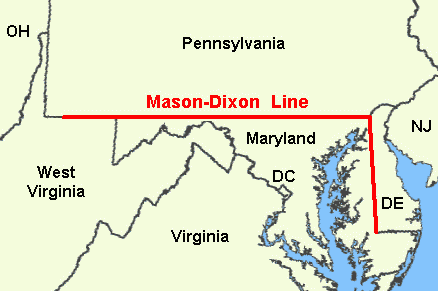
Why Is information technology Called the Stonemason-Dixon Line?
It is called the Mason and Dixon Line because the two men who originally surveyed the line and got the governments of Delaware, Pennsylvania and Maryland to hold, were named Charles Bricklayer and Jeremiah Dixon.
Jeremiah was a Quaker and from a mining family. He showed a talent early on for maths and then surveying. He went down to London to be taken on by the Regal Social club, merely at a time when his social life was getting a bit out of hand.
He was a flake of a lad by all accounts, not your typical Quaker, and never married. He enjoyed socialising and carousing and was actually expelled from the Quakers for his drinking and keeping loose company.
Mason's early life was more than sedate by comparing. At the age of 28 he was taken on by the Royal Observatory in Greenwich as an assistant. Noted as a "meticulous observer of nature and geography" he later became a fellow of the Royal Society.
Mason and Dixon arrived in Philadelphia on fifteen November 1763. Although the war in America had concluded some two years earlier, in that location remained considerable tension between the settlers and their native neighbours.
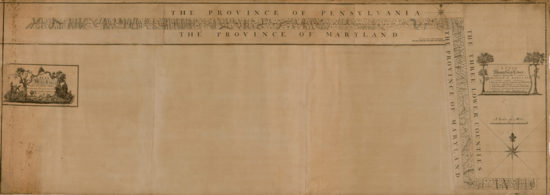
The line was not chosen the Mason-Dixon Line when it was first drawn. Instead, it got this proper name during the Missouri Compromise, which was agreed to in 1820.
It was used to reference the boundary between states where slavery was legal and states where it was not. After this, both the proper noun and its understood significant became more widespread, and it eventually became part of the border betwixt the seceded Amalgamated States of America and Union Territories.
Why Do We Take a Bricklayer-Dixon Line?
In the early days of British colonialism in N America, land was granted to individuals or corporations via charters, which were given by the rex himself.
However, even kings tin can make mistakes, and when Charles Two granted William Penn a lease for land in America, he gave him territory that he had already granted to both Maryland and Delaware! What an idiot!?
William Penn was a writer, early fellow member of the Religious Guild of Friends (Quakers), and founder of the English N American colony the Province of Pennsylvania. He was an early advocate of democracy and religious freedom, notable for his good relations and successful treaties with the Lenape Native Americans.
Under his direction, the metropolis of Philadelphia was planned and adult. Philadelphia was planned out to be grid-similar with its streets and be very easy to navigate, unlike London where Penn was from. The streets are named with numbers and tree names. He chose to apply the names of trees for the cross streets because Pennsylvania means "Penn's Woods".
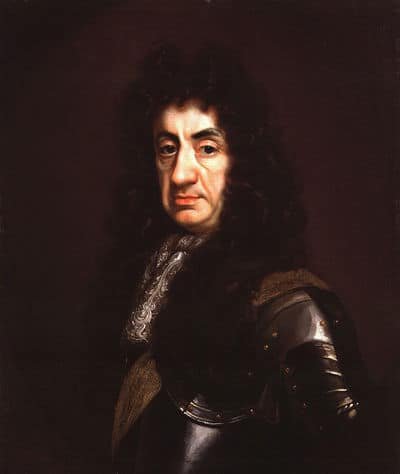
Merely in his defense, the map he was using was inaccurate, and this threw everything out of whack. At first, it wasn't a huge issue since the population in the area was so sparse at that place were non many disputes related to the border.
But as all the colonies grew in population and sought to aggrandize w, the matter of the unresolved edge became a much more than prominent in mid-Atlantic politics.
The Feud
In colonial times, as in modern times, too, borders and boundaries were critical. Provincial governors needed them to ensure they were collecting their due taxes, and citizens needed to know which land they had a right to merits and which belonged to someone else (of grade, they didn't seem to mind too much when that 'someone else' was a tribe of Native Americans).
The dispute had its origins almost a century before in the somewhat confusing proprietary grants by Rex Charles I to Lord Baltimore (Maryland) and by King Charles II to William Penn (Pennsylvania and Delaware). Lord Baltimore was an English language nobleman who was the first Proprietor of the Province of Maryland, 9th Proprietary Governor of the Colony of Newfoundland and second of the colony of Province of Avalon to its southeast. His title was "Beginning Lord Proprietary, Earl Palatine of the Provinces of Maryland and Avalon in America".
A problem arose when Charles II granted a lease for Pennsylvania in 1681. The grant defined Pennsylvania's southern border as identical to Maryland's northern border, merely described it differently, as Charles relied on an inaccurate map. The terms of the grant clearly indicate that Charles Ii and William Penn believed the 40th parallel would intersect the Twelve-Mile Circle around New Castle, Delaware, when in fact it falls north of the original boundaries of the Metropolis of Philadelphia, the site of which Penn had already selected for his colony'southward capital metropolis. Negotiations ensued after the problem was discovered in 1681.
As a result, solving this border dispute became a major consequence, and it became an even bigger bargain when tearing disharmonize broke out in the mid-1730s over state claimed by both people from Pennsylvania and Maryland. This trivial event became known as Cresap'southward War.
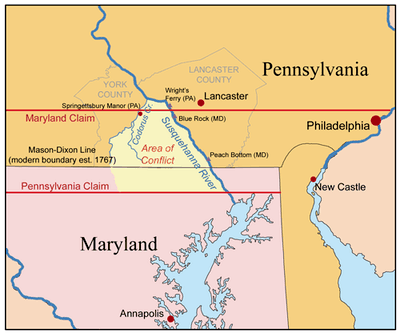
To finish this madness, the Penns, who controlled Pennsylvania, and the Calverts, who were in charge of Maryland, hired Charles Mason and Jeremiah Dixon to survey the territory and depict a purlieus line to which everyone could hold.
But Charles Mason and Jeremiah Dixon just did this because the Maryland governor had agreed to a border with Delaware. He later argued the terms he signed to were not the ones he had agreed to in person, but the courts made him stick to what was on paper. E'er read the fine print!
This agreement made it easier to settle the dispute betwixt Pennsylvania and Maryland because they could use the now established boundary between Maryland and Delaware as a reference. All they had to exercise was extend a line west from the southern boundary of Philadelphia, and…
The Stonemason-Dixon Line was born.
Limestone markers measuring upwardly to 5ft (1.5m) high – quarried and transported from England – were placed at every mile and marked with a P for Pennsylvania and M for Maryland on each side. Then-called Crown stones were positioned every five miles and engraved with the Penn family'southward coat of arms on one side and the Calvert family's on the other.
Later, in 1779, Pennsylvania and Virginia agreed to extend the Mason-Dixon Line west by five degrees of longitude to create the border between the 2 colines-turned-states (By 1779, the American Revolution was underway and the colonies were no longer colonies).
In 1784, surveyors David Rittenhouse and Andrew Ellicott and their crew completed the survey of the Bricklayer–Dixon line to the southwest corner of Pennsylvania, v degrees from the Delaware River.
Rittenhouse's coiffure completed the survey of the Stonemason–Dixon line to the southwest corner of Pennsylvania, five degrees from the Delaware River. Other surveyors continued west to the Ohio River. The section of the line between the southwestern corner of Pennsylvania and the river is the county line betwixt Marshall and Wetzel counties, West Virginia.
In 1863, during the American Ceremonious War, Due west Virginia separated from Virginia and rejoined the Union, but the line remained as the border with Pennsylvania.
Information technology'southward updated several times throughout history, the most recent being during the Kennedy Administration, in 1963.
The Stonemason-Dixon Line's Identify in History
The Mason–Dixon line along the southern Pennsylvania border later became informally known equally the boundary between the gratuitous (Northern) states and the slave (Southern) states.
It is unlikely that Mason and Dixon ever heard the phrase "Mason–Dixon line". The official study on the survey, issued in 1768, did non even mention their names. While the term was used occasionally in the decades following the survey, information technology came into popular employ when the Missouri Compromise of 1820 named "Mason and Dixon's line" as part of the boundary between slave territory and gratis territory.
The Missouri Compromise of 1820 was United states of america federal legislation that stopped northern attempts to forever prohibit slavery'south expansion by albeit Missouri as a slave state in exchange for legislation which prohibited slavery north of the 36°thirty′ parallel except for Missouri. The 16th The states Congress passed the legislation on March 3, 1820, and President James Monroe signed information technology on March 6, 1820.
At showtime glance, the Stonemason and Dixon Line doesn't seem like much more than a line on a map. Plus, it was created out of a conflict brought on by poor mapping in the first place…a trouble more lines aren't likely to solve.
Just despite its lowly condition equally a line on a map, it eventually gained prominence in United States history and commonage memory because of what information technology came to hateful to some segments of the American population.
Information technology commencement took on this meaning in 1780 when Pennsylvania abolished slavery. Over time, more than northern states would practice the aforementioned until all us north of the line did not allow slavery. This made it the border between slave states and free states.
Maybe the biggest reason this is pregnant has to exercise with the underground resistance to slavery that took place almost from the institution'south inception. Slaves who managed to escape from their plantations would try to brand their way north, past the Mason-Dixon Line.
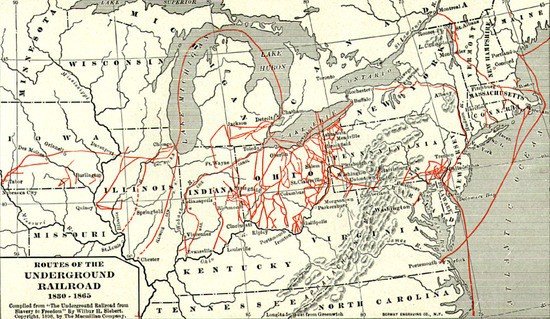
Notwithstanding, in the early years of U.s.a. history, when slavery was all the same legal in some Northern states and fugitive slave laws required anyone who found a slave to return him or her to their owner, meaning Canada was ofttimes the final destination. Yet it was no hush-hush the journey got slightly easier afterwards crossing the Line and making it into Pennsylvania.
Because of this, the Mason-Dixon Line became a symbol in the quest for liberty. Making it beyond significantly improved your chances of making it to liberty.
Today, the Mason-Dixon Line does not have the same significance (plain, since slavery is no longer legal) although it still serves as a useful demarcation in terms of American politics.
The "South" is nevertheless considered to commencement below the line, and political views and cultures tend to change dramatically once past the line and into Virginia, Due west Virginia, Kentucky, North Carolina, and so on.
Beyond this, the line however serves as the border, and anytime ii groups of people tin agree on a border for a long fourth dimension, anybody wins. There'due south less fighting and more peace.
The Line and Social Attitudes
Because when studying the Us history the most racist stuff e'er comes from the S, it's easy to fall into the trap of thinking the N was as progressive every bit the South was racist.
But this but isn't true. Instead, people in the North were just every bit racist, but they went about it in different ways. They were more subtle. Sneakier. And they were quick to judge Southern racist, pushing attending away from them.
In fact, segregation yet existed in many northern cities, particularly when it came to housing, and attitudes towards blacks were far from warm and welcoming. Boston, a urban center very much in the Due north, has had a long history of racism, withal Massachusetts was one of the offset states to abolish slavery.
As a result, to say the Mason-Dixon Line separated the country past social mental attitude is a gross mischaracterization.
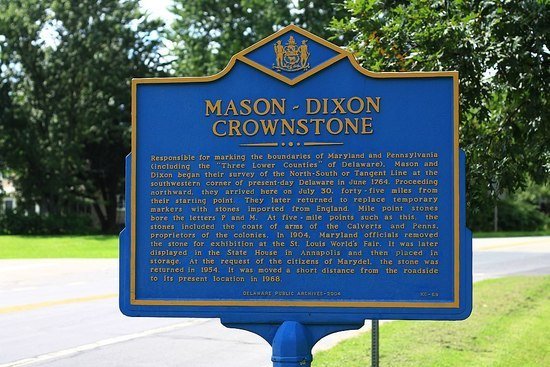
formulanone from Huntsville, U.s.a. [CC BY-SA two.0
Information technology's truthful that blacks were generally safer in the Due north than in the S, where lynchings and other mob violence were quite common all the way up until the ceremonious rights movement in the 1950s and 1960s.
But the Mason-Dixon Line is best understood as the unofficial border between the North and the South as well as the divider betwixt free and slave states.
The Futurity of the Stonemason-Dixon Line
Although information technology still serves every bit the border of three states, the Mason-Dixon Line is most likely waning in significance. Its unofficial role as a border betwixt the North and Southward only really remains because of the political differences betwixt the states on each side.
However, the political dynamic in the country is changing rapidly, especially as demographics shift. What this will exercise to the difference between North and South, who knows?
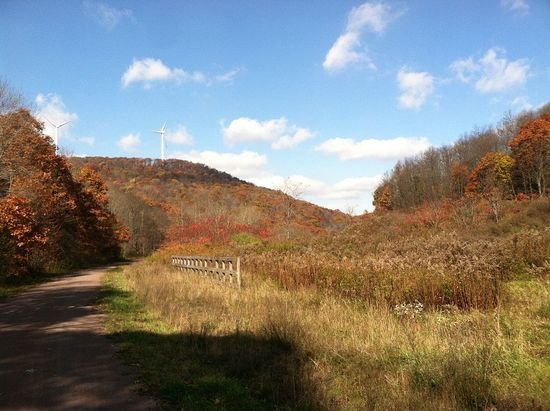
Jbrown620 at English language Wikipedia [CC BY-SA 3.0
If we use history every bit a guide, it'south safe to say the line will continue to serve some significance if in nothing else except our collective consciousness. But maps are redrawn constantly. What's a timeless edge today can be a forgotten boundary tomorrow. History is withal existence written.
READ MORE:
The Great Compromise of 1787
The 3-Fifths Compromise
grasssamissing1973.blogspot.com
Source: https://historycooperative.org/mason-dixon-line/
0 Response to "How Can I Change the Size of Inserted Clip Art Without Changing the Shape"
Post a Comment